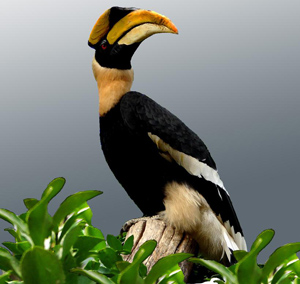Tongues tied around tatu-bola
Updated: 2014-06-10 07:32
By Yang Wanli (China Daily)
|
||||||||
 |
| TOUCANS: Similar in appearance to the ‘god bird’ of Yunnan province, toucans are native to South America and are hugely popular as pets worldwide. [Provided to China Daily] |
 |
| IN POPULAR CULTURE: The toucan is instantly recognizable globally after the success of Rio 2, an animal-themed animation that took more than $16 million at the box office in the week after it opened in China. |
 |
| HORNBILLS: Known as the ‘god bird’, and worshipped by the Jingpo, ethnic group in Yunnan province, hornbills originated in tropical and subtropical Africa, Asia and Melanesia. Some species are almost extinct. |
"Pangolins have no teeth. So for several years they were placed in the order Edentata," Wang said. "However, they also lack several skeletal structures unique to the edentates, so they were placed in their own order. That's how scientists work to classify animals. It's not based on appearance, but something 'deep' under the skin," he said.
The 'god bird'
Cute though the tatu-bola is, some Brazilians were surprised by their country's choice of "Fuleco", as the mascot has been named. Lidia Ferranti, a lawyer in Sao Paulo said she isn't fond of the mascot, but understood why it had been chosen. "I think it's a good idea to choose it as our mascot because it's a Brazilian animal and we have a lot of them in our country," she said.
Conversely, Matheus Tales, a student from Moura Lacerda Central University, was adamant that the choice was wrong. "It is not a famous animal in Brazil, and I don't think it will help foreigners to remember Brazil in the same way they remember the panda from the 2008 Beijing Olympic Games," he said, adding that he would like to see a panda in Brazil at some time.
Ferranti agreed with that sentiment. "I think the panda is one of the cutest animals in the world, and I really hope to see one with my own eyes some day," she said. "I hope the Chinese government will loan one to Brazil, as it has other countries. I'm sure that all Brazilians would like the idea and would visit the zoo just to see it."
Tales has his own suggestion. "I think the toucan would have been a much better choice," he said. "It's lovely and is also known by a greater number of people internationally."
The toucan is instantly recognizable globally after the success of Rio 2, an animal-themed animation that took more than $16 million at the box office in the week after it opened in China. "Rafael", a suave and charming toucan with a huge black and yellow bill, made a strong impression on Chinese audiences.
As Rafael's popularity grew, a newspaper in southwest China reported that the toucan may have originated in the southwestern province of Yunnan. "It was adopted as a 'god bird', connected to the god once worshipped by the Jingpo ethnic group in the south of the province," the newspaper said.
Sadly, the supposition is incorrect, according to avian experts. "The toucan's home is the tropical forests of South America. Its oversized, colorful bill has made it one of the world's most popular birds," said Yang Xiaojun of the China Ornithological Society.
Toucans usually lay two to four eggs a year in their nests, hidden away in holes in tree stumps. Both parents care for the chicks. Young toucans do not have a large bill at birth - it grows as they develop and does not reach its full size until several months after hatching. The birds are very popular as pets, and many are captured to supply the trade.
"We do have a beautiful bird with a large, colorful bill in China. And it is indeed the 'god bird' for the Jingpo people in Yunnan," said Han Lianxian, an avian expert at Southwest Forestry University. "But the name of the bird is the hornbill, not toucan."
Hornbills originated in tropical and subtropical Africa, Asia and Melanesia, and are characterized by a long, downward-curving bill, which is frequently brightly colored and sometimes has a casque, a small helmet-shaped structure, on the upper mandible.
The birds are omnivorous, feeding on fruit and small animals, according to Han, who said hornbills are monogamous and nest in natural cavities in trees and sometimes on cliffs. A number of hornbill species - mainly the insular species with limited flight range - are on the verge of becoming extinct.
|
The Brazilian slider, a popular pet in China, is a threat to indigenous Chinese turtles. YANG FAN / FOR CHINA DAILY An exotic, but potentially dangerous import As an expert on amphibians and reptiles, it's hardly surprising that Rao Dingqi's 15-square-meter office at the Kunming Institute of Zoology is packed with weighty tomes relating to turtles, snakes, frogs and other creatures. Several glass cases that sit on and under his desk contain a menagerie of stuffed animals, most of them collected earlier this year. According to Rao, the best-known animal import from South America is the Brazilian slider, a turtle commonly seen in China and often kept as a pet. "It was firstly introduced to Taiwan, and is very easy to feed because it will eat almost anything, including shrimps, vegetables, fruit, carrion and small fish. It's also very adaptable and can live in temperatures ranging from 10 C to 35 C. These factors have been favorable to the rapid spread of the Brazilian slider in China," Rao said. The slider was introduced to the Chinese mainland in the 1980s. According to Rao, it quickly became a popular dish in southern parts of the country, but Buddhists also like to buy the slider as a gift for their temples, because saving a life, any life, is a laudable activity. For Rao, though, the turtle is an unwanted guest. "This invasive species can seriously threaten and destroy the local environment and harm biological diversity because of its high rate of reproduction and adaptability," Rao said, adding that the number of indigenous turtle species in China is very limited. "Local species will be severely threatened by the loss of habitat and food supply, which may result in them being driven to the brink of extinction. The management of invasive species is now an urgent matter," he said. Rao urged the establishment of a department to supervise and control invasive species, both flora and fauna: "Measures to limit their growth area and control their numbers to prevent a population boom should be introduced as soon as possible. The introduction of invasive species is relatively inexpensive, but controlling them can be very costly." Guo Anfei in Kunming contributed to this story.
|
According to Han, the long bills of both toucans and hornbills have a number of functions. As a weapon, the bill is more for show than substance, but it's a very useful feeding tool. The birds use their bills to reach fruit on branches too small to support their weight, and also to skin their pickings.
"One species called the wreathed hornbill is a famous commercial mascot known for its casque-made decorations," Han said, adding that the bird has been listed in the Convention on International Trade in Endangered Species of Wild Flora and Fauna, and is under State protection.
Tree of life
There are many similarities between the flora of Brazil and China, but, once again, appearances can be deceptive.
"In fact, botanical species are also totally different in the two countries," said Shui Yumin, a botanist from Kunming Institute of Botany at the Chinese Academy of Science, who undertook a scientific expedition to French Guiana earlier this year.
He said South American plants are usually more brightly colored and larger than their Chinese "counterparts".
"Unlike plants in South America, which mainly rely on bees for pollination, plants in Asia usually depend on birds or even bigger animals, such as monkeys, to disperse their seeds," Shui said. As with animals, botanical taxonomy also classifies flora based on several factors, including physiological, chemical and also metabolic characteristics.
"Appearance just counts for one of millions of reasons that suggest 'blood ties' between two species," Shui said. In terms of botany, China has a unique character. "There's a wider range of botanical diversity here, including 'ancestor' species and highly evolved sub-species," he said, adding that diversity in South America is illustrated by the wide variety of genera and species.
Shui used the image of a tree to illustrate his point: "The botanical system in Asia is like a pine tree with well-proportioned stems, branches and leaves, while the system in South America is like a coconut tree in that most of its characteristics are at the top," he said.
Proving a close relationship between plants in Brazil and China appears extremely difficult, but Shui said a few well-known Chinese staples definitely originated in the South American country.
Corn, chilies and even potatoes were all imported from Brazil, and their pleasant tastes and ease of cultivation ensured that the three plants quickly spread across China to become staple foodstuffs.
"Continental drift resulted in connections between living things on Earth. However, hundreds of millions years of development resulted in a huge number of distinctive features. In some cases, people have been confused by the apparent similarities and have raised questions or doubts. And that's a good thing, because science is the process of knowing," Shui said.
Contact the writer at yangwanli@chinadaily.com.cn
Zhang Fan in Brazil and Guo Anfei in Kunming contributed to this story.
Most Viewed
Editor's Picks

|

|

|

|

|

|
Today's Top News
Virginia's governor deepens China ties
Experts take aim at 'biased' Pentagon report on China
Baidu gets ex-Google scientist Ng in race for AI research
Miss Nevada Nia Sanchez crowned as 63rd Miss USA
Chinese navy to join 2014 RIMPAC naval drill
5 dead in Las Vegas shooting
Bergdahl says he was tortured
China's exports rebound in May
US Weekly

|

|
















